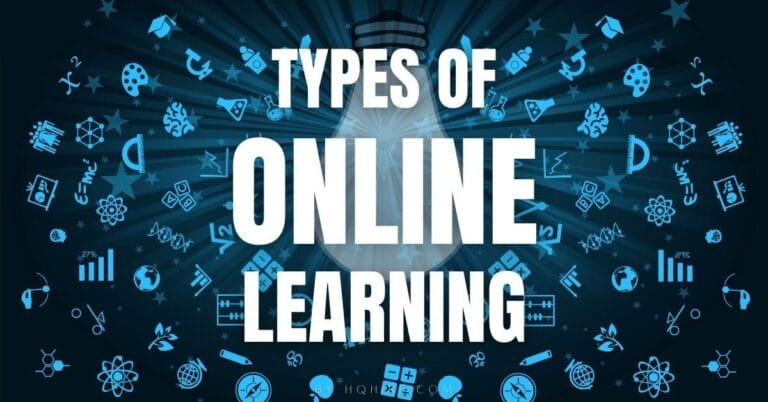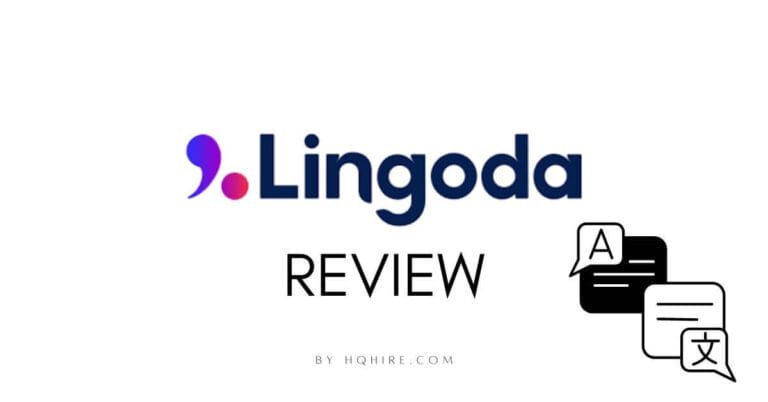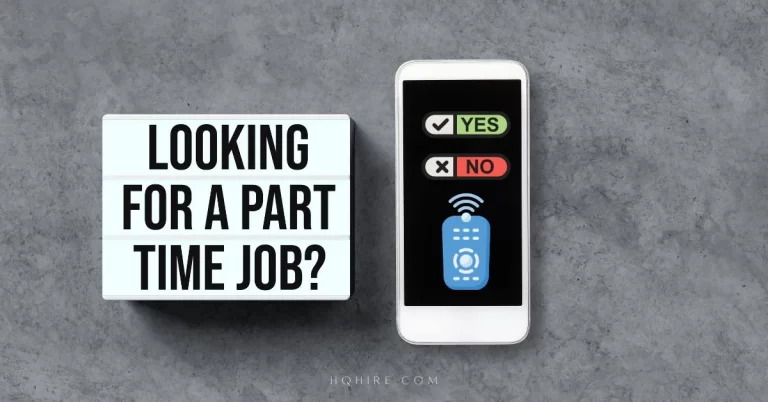Goal setting is the process of creating a plan to achieve a specific result. No matter what you’re trying to achieve in life, setting goals is a critical part of the process.
Understanding and knowing the right goal setting-techniques can help motivate you to achieve your goals.
If you are working towards your career goals, accomplishing projects, leading a team, or simply trying to set more effective goals at work, these goal-setting methodologies will probably help you.
What Is A Goal Setting Technique?
A goal-setting technique is a process used to set realistic goals that are purposeful and explicit. All goal-setting techniques help you to identify what you want to achieve and figure out the steps necessary to get there.
Generally, the goal-setting process follows the following framework of success:
- Identifying and writing down your goals.
- Determine the steps you need to take.
- Create a timeline for achieving the goal.
- Make an action plan, then review and evaluate your goal.
- Take action and accomplish your goal.
There are many different types of goal-setting techniques, each one offering a different approach to the process.
The key is to use the right tools and stick with them for the long haul.
Common Types Of Goal-Setting Techniques
Goal setting is a great way for you to visualize and understand how you can achieve a specific outcome.
Each approach to goal-setting is suited for different situations:
- Some goal-setting techniques are great for setting goals for a group or organization, while others are good for great for setting individual goals.
- Some goal-setting techniques are great for setting long-term goals, while others are good for great for setting short-term goals.
| Common Goal Setting Techniques | Description |
|---|---|
| SMART Goals | SMART is the acronym that stands for Specific, Measurable, Achievable, Relevant or Realistic, and Time-bound. A goal-setting technique that measures the outcome of the process. |
| FAST Goals | FAST is the acronym that stands for Frequently discussed, Ambitious, Specific, and Transparent. A goal-setting technique that helps the strategic alignment of a group of individuals. |
| CLEAR Goals | CLEAR is the acronym that stands for Collaborative, Limited, Emotional, Appreciable, and Refinable. A goal-setting technique that puts emphasis on people, it is used for group goal-setting. |
| PACT Goals | PACT is the acronym that stands for Purposeful, Actionable, Consistent, and Trackable. A goal-setting technique that measures the output instead of the results. |
| WISE Goals | WISE is the acronym that stands for Written, Integrated, Synergistic and Expansive. A goal-setting technique is used in conjunction with other goal-setting techniques to have a bigger picture of how to move an individual closer to the goal. |
SMART Goals
SMART goal is the most popular goal-setting tool that emphasizes the objective measurement of the outcome and how it will play a part in achieving the bigger goal. SMART goal setting is suited for both individuals and organizations to set and achieve long-term goals.

SMART is the acronym for Specific, Measurable, Achievable, Relevant, and Time-bound.
- Specific: Specific goals are goals that are clearly defined to align with the objectives that a person or organization sets to achieve a certain outcome.
- Measurable: Measurable goals are goals that can be quantitatively assessed. For example, “I want to increase my reading speed by 50% in the next six months” is a measurable goal because it can be quantitatively assessed (i.e. how much faster did your reading speed increase by?).
- Achievable: Achievable goals are goals that you know you have the resources and the ability to achieve.
- Relevant: Relevant goals are goals that are relevant to your final objective, it should be a goal that helps to bring you closer to what you want
- Time-bound: Time-bounded goals are goals that have a specific time frame associated with them. This can be helpful in motivating people to achieve their goals, as they know that they will eventually need to complete them. However, it can also be a challenge, as people may feel pressure to achieve their goals within the set timeframe.
FAST Goals
FAST goal emphasizes the alignment of the strategic priorities between parties when pursuing the goal. It helps individuals or groups to focus on what they want to achieve and how they will achieve it. FAST goal setting is suited for an organization’s objective setting or a situation where more than one individual is involved.
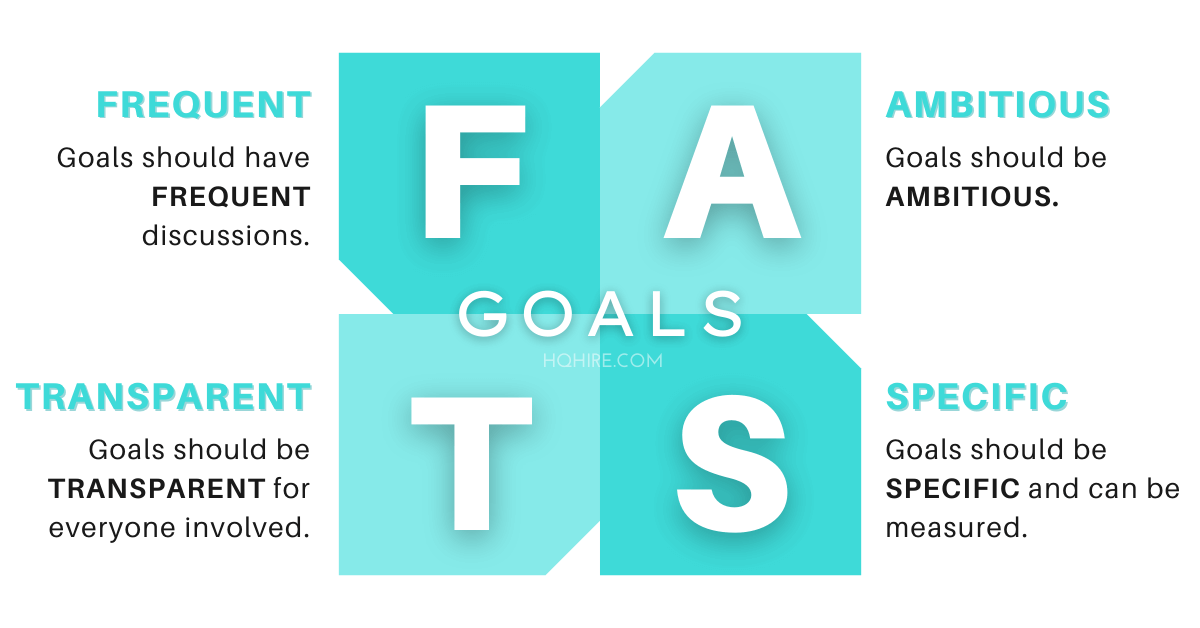
FAST is the acronym for Frequent discussion, Ambitious, Specific, and Transparent.
- Frequently discussed: Frequent discussion should be done to enable course corrections due to changes, this enables agility in the goals that are being set.
- Ambitious: Ambitious goals all allow improve performance and continuous advancement.
- Specific: Specific goals can be measured so that we can identify what is working and what is not.
- Transparent: Transparent goals for everyone involved, so that we can remove activities that are unaligned with our goals.
CLEAR Goals
CLEAR goals is a project management tool that allows the leadership team to set realistic, actionable goals. CLEAR Goal setting can help to set team objectives or team goals. It is a goal-setting strategy that allows you to adapt and be agile when new information or situation arises.
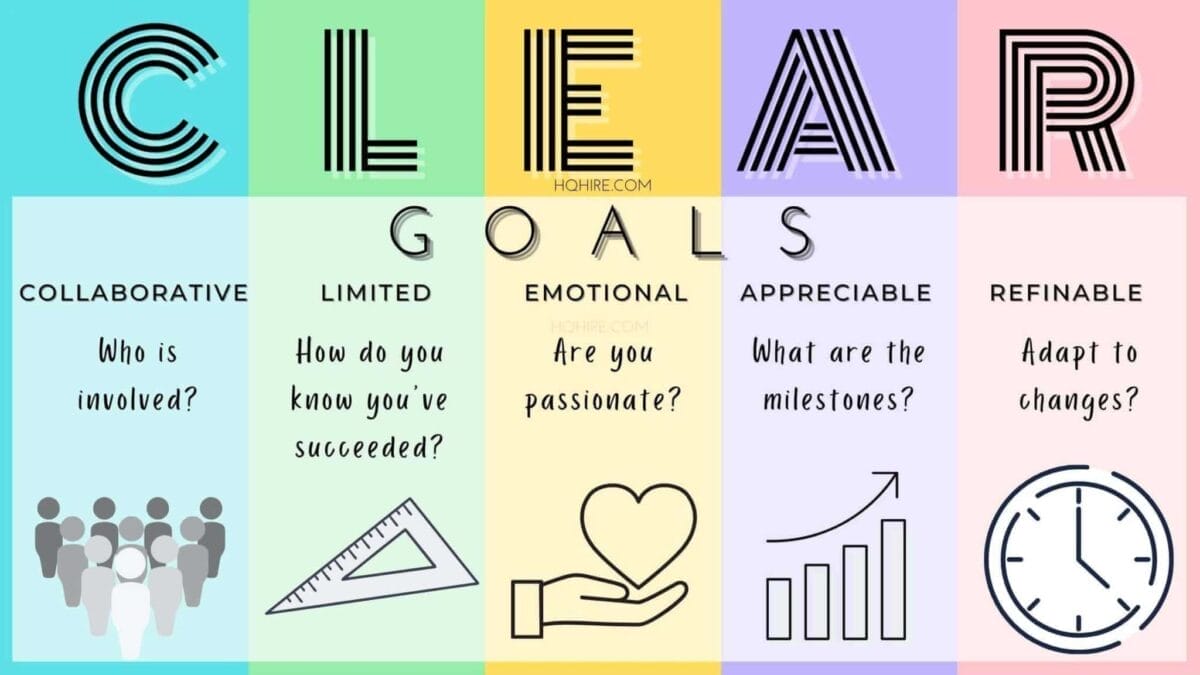
CLEAR is the acronym for Collaborative, Limited, Emotional, Appreciable, and Refinable.
- Collaborative: Goals are achieved in collaboration with the help of another party. This is especially important in human society, where we live as a big community.
- Limited: Set a limit to the time and the scope of your goal. Your goal’s duration and scope should be clear and achievable.
- Emotional: Understand the emotions and know-how this goal connects with the employees and taps into their energy and passion.
- Appreciable: Break down the big ambitious goals into smaller actionable goals so that you can take small but continuous steps towards achieving the final goal.
- Refinable: Set goals with a clear objective, but be open to the opportunity to refine and modify your goals accordingly when the situation arose.
PACT Goals
PACT goals are a useful strategy when you are setting long-term goals. PACT measures your output instead of your results. By measuring your output, you will get more sense of accomplishment, even when the results may not be as apparent. PACT goals help you to set realistic goals and allow you to feel happier while pursuing your goal.
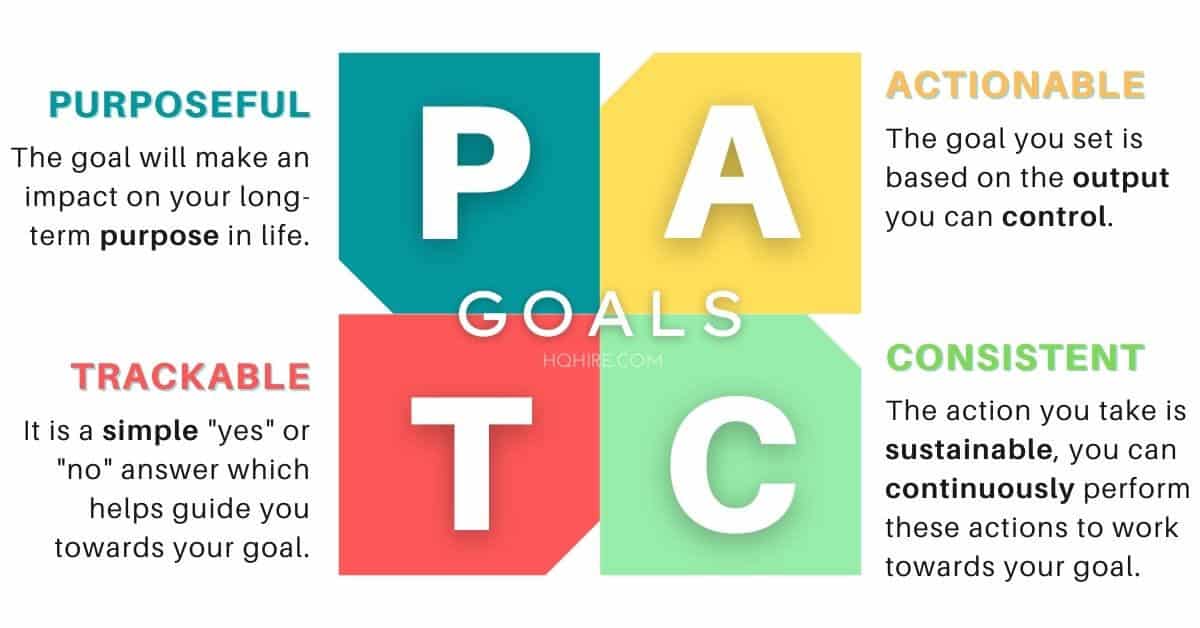
PACT is the acronym for Purposeful, Actionable, Consistent, and Trackable.
- Purposeful: What you do needs to be purposeful and it needs to be something that will make an impact on your long-term purpose in life.
- Actionable: The goal needs to be based on the output which you can control.
- Consistent: Consistency and sustainability are built into your goal, this helps you to follow through and motivate you to reach your goal.
- Trackable: Tracking is possible when you are performing a periodic review on your process, a simple “yes” or “no” answer will be sufficient to allow you to track your goals.
WISE Goals
WISE goals help to give a bigger picture of why we are doing what we are doing. It gives us a reason why the actions we take matter. WISE goals help you to set goals that genuinely help you closer to your vision.
WISE goals are exceptionally useful when used with other goal-setting strategies such as SMART goals, or FAST goals.
By integrating and synergizing ideas into your actions, you’ll take lesser effort to achieve results.
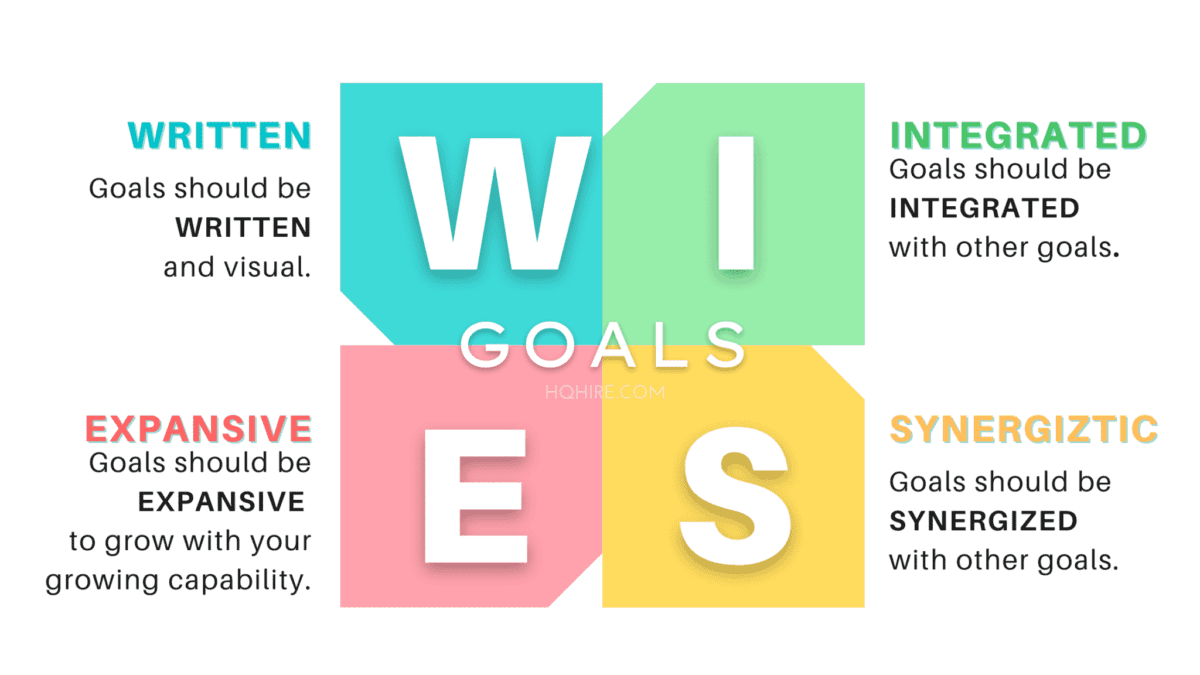
WISE is the acronym for Written, Integrated, Synergistic, and Expansive.
- Witten: Written goals allow you to look at your plan objectively, making changes as required for you to reach your final goal.
- Integrated: Goals can be integrated with other goals so that you can put all your ideas together in the same place. This gives you a clearer picture of what needed to be done, and what actions you need to do them.
- Synergistic: Create a synergy on the integrated goals and look for opportunities where you can make them work as one. It is to keep your final goal in mind when you plan your actions and the ability to use the least amount of effort to achieve the maximum amount of results.
- Expansive: Expansive is the ability for your goal to grow and adapt with time in accordance with your capability into something more than you have ever imagined.
Powerful Goal-Setting Techniques and Frameworks
While everyone knows about SMART goal setting and even FAST goal setting, there are also other types of less known but equally powerful goal setting technique you may want to know to become a high achiever for your goals.
BHAG Goals
Setting Big, Hairy, Audacious Goals (BHAG) involves defining ambitious and long-term objectives that inspire and motivate. These goals are often visionary and challenging.
Characteristics:
- Ambitious Vision: BHAGs are characterized by a grand vision that stretches beyond conventional thinking.
- Long-Term Horizon: These goals extend over an extended period, typically 10 to 30 years.
- Motivational Impact: BHAGs serve as powerful motivators, driving individuals and organizations to achieve remarkable feats.
Micro Goals
Micro goals involve breaking down larger objectives into smaller, manageable tasks. This approach facilitates progress and ensures a sense of accomplishment.
Characteristics:
- Incremental Progress: Micro goals focus on small, achievable steps to make steady progress.
- Manageable Tasks: Breaking down larger goals into micro goals makes the overall objective less overwhelming.
- Frequent Achievements: Achieving micro goals provides a sense of accomplishment, boosting motivation.
GROWTH Goal Setting
GROWTH is a goal-setting framework that stands for Goals, Reality, Options, Will, Tactics, and Habits. It provides a structured approach to goal planning.
Characteristics:
- Comprehensive Planning: GROWTH considers various aspects, including current reality, available options, and tactics.
- Emphasis on Habits: The framework highlights the importance of cultivating habits to support goal achievement.
- Action-Oriented: GROWTH encourages the development of specific actions and tactics to reach defined goals.
BSQ Goals
BSQ, or Balanced Scorecard Quadrants, involves using the balanced scorecard methodology to set and manage goals across four perspectives: financial, customer, internal processes, and learning/growth.
Characteristics:
- Holistic Perspective: BSQ considers multiple dimensions, ensuring a well-rounded approach to goal setting.
- Strategic Alignment: Goals are aligned with the organization’s overall strategy across different perspectives.
- Performance Measurement: The balanced scorecard enables the tracking of performance in various key areas.
HARD Goals
HARD goals, standing for Heartfelt, Animated, Required, and Difficult, provide a framework for setting goals that are meaningful, energizing, necessary, and challenging.
Characteristics:
- Emotional Connection: HARD goals are characterized by a deep, heartfelt connection, making them more motivating.
- Energizing Nature: These goals should generate enthusiasm and animation, driving sustained effort.
- Necessity and Challenge: HARD goals are both required for success and present a considerable challenge.
WOOP Goals
WOOP, an acronym for Wish, Outcome, Obstacle, Plan, is a goal-setting method that combines dreaming about a desired future with realistic planning.
Characteristics:
- Positive Visualization: WOOP encourages the visualization of a desired outcome, fostering a positive mindset.
- Obstacle Identification: Anticipating and addressing potential obstacles enhances goal planning.
- Concrete Planning: The method emphasizes creating specific plans to overcome obstacles and achieve goals.
Goal Pyramid
The Goal Pyramid involves structuring goals hierarchically, with smaller goals forming the base and leading to the accomplishment of a larger, overarching goal at the pinnacle.
Characteristics:
- Hierarchy of Goals: Goals are organized in a pyramid, with smaller goals supporting the achievement of more significant objectives.
- Step-by-Step Approach: Breaking down goals into tiers allows for a step-by-step progression toward the ultimate goal.
- Visual Representation: The pyramid serves as a visual representation of the interconnectedness of goals.
KRA Goals
Key Results Areas (KRA) involve identifying and setting goals in specific areas crucial to an individual or organization’s success. These areas are essential for overall effectiveness.
Characteristics:
- Strategic Focus: KRA goals are strategically aligned with the key areas critical for success.
- Performance Measurement: Goals are set based on measurable outcomes within key result areas.
- Customized to Roles: KRA goals can be customized to individual roles or organizational functions, ensuring relevance.
One-Word Goals
The concept of One-Word Goals involves choosing a single word that encapsulates the overarching theme or focus for a specific period, guiding actions and decisions.
Characteristics:
- Simplicity: One-Word Goals simplify focus by distilling complex aspirations into a single, easily remembered word.
- Versatility: The chosen word can be broad enough to encompass various aspects of life or specific to a particular goal.
- Mindfulness: One-Word Goals promote mindfulness, encouraging regular reflection on actions aligned with the chosen word.
Locke and Latham Goal Setting
Locke and Latham’s goal-setting theory emphasizes the importance of specific and challenging goals in motivating individuals and improving performance.
Characteristics:
- Clarity and Specificity: Goals should be clear, specific, and well-defined for effective implementation.
- Challenging Nature: The theory asserts that challenging goals lead to higher performance and greater effort.
- Feedback and Adaptation: Continuous feedback and adjustments to goals contribute to ongoing improvement and success.
Backward Goals
Backward goal-setting involves starting with the desired end result and working backward to determine the steps needed to achieve that outcome.
Characteristics:
- Reverse Planning: Backward goals reverse the traditional planning process by starting with the end goal.
- Clarity of Vision: Knowing the desired outcome provides a clear vision, making it easier to identify necessary actions.
- Adaptability: The approach allows for flexibility and adjustment as individuals or organizations progress toward their goals.
Management By Objective (MBO) Goals
Management By Objectives (MBO) is a goal-setting approach that involves collaboratively setting goals with employees to enhance organizational performance.
Characteristics:
- Participatory Goal Setting: MBO involves employees in the goal-setting process, fostering engagement and commitment.
- Clear Objectives: Goals are specific, measurable, achievable, relevant, and time-bound (SMART), providing clarity.
- Performance Evaluation: Regular reviews assess progress, allowing for adjustments and recognition of achievements.
OKR Framework
Objectives and Key Results (OKR) is a goal-setting framework that aligns individual, team, and organizational goals by defining clear objectives and measurable key results.
Characteristics:
- Alignment: OKRs ensure alignment of individual and team objectives with overarching organizational goals.
- Measurable Outcomes: Key Results provide quantifiable metrics, enabling objective assessment of goal attainment.
- Regular Check-Ins: OKRs often involve regular check-ins and adjustments to maintain agility and responsiveness.
OGSM Framework
Objectives, Goals, Strategies, and Measures (OGSM) is a strategic planning framework that connects high-level objectives with specific strategies and measures to guide organizational success.
Characteristics:
- Holistic Planning: OGSM considers various elements, from overall objectives to actionable strategies and measurable outcomes.
- Strategic Alignment: Goals and strategies are aligned with the organization’s mission and long-term vision.
- Performance Measurement: Measures provide a quantitative basis for evaluating the achievement of goals and strategies.
GOST Framework
The GOST Framework is a goal-setting approach that focuses on Goals, Objectives, Strategies, and Tactics to guide individuals or organizations toward achieving desired outcomes.
Characteristics:
- Clarity in Goals: GOST emphasizes setting clear and specific goals to provide a sense of direction.
- Strategic Planning: Objectives and strategies are aligned to ensure a cohesive and purposeful approach.
- Actionable Tactics: The inclusion of tactics ensures a practical and executable plan for achieving set objectives.
Hoshin Kanri
Hoshin Kanri, often called Policy Deployment, is a strategic planning method originating from Japanese management philosophies, aiming to align strategic goals throughout an organization.
Characteristics:
- Catchball Approach: Hoshin Kanri involves a collaborative, iterative dialogue to ensure alignment across all levels of the organization.
- Visual Management: Visual tools, such as strategy deployment matrices, help communicate and track progress.
- Continuous Improvement: The method emphasizes ongoing reflection and adjustment to adapt to changing circumstances.
Quality Function Deployment (QFD) Methodology
Quality Function Deployment (QFD) is a methodology that translates customer needs and requirements into product or service features to ensure customer satisfaction.
Characteristics:
- Customer-Centric: QFD starts with understanding and prioritizing customer requirements.
- Cross-Functional Collaboration: It involves collaboration between different functions to ensure alignment with customer needs.
- Prioritization: QFD assigns priorities to features based on their impact on customer satisfaction, guiding development efforts.
Why Are Setting Goals Important?
Setting goals is important because it gives us a roadmap to follow and helps us stay on track. Without goals, we can easily become sidetracked and lose focus on what’s important. Having specific goals also allows us to measure our progress and make necessary adjustments along the way.
A study by Harvard Business reveals that goal setting can help you succeed further and faster.
- 14% of people have goals and have a plan in mind.
- 97% of people don’t write down their goals.
- 3% of the people with written goals earn 10 times more than those who don’t.
Ultimately, setting goals can help us achieve our desired outcome more efficiently and effectively.
Goal setting is essential if we want to succeed in whatever we do.
What Are The Qualities Of Effective Goal Setting?
Effective goal setting is an essential component of the success cycle, as it involves formulating objectives that are attainable and meaningful to the individual.
The qualities inherent in effective goal setting include;
- Ability to have clear objectives for each task.
- Ability to establish measurable progress while working on the goal.
- Ability to maintain motivation and accountability.
- Ability to focus on consistent effort and persevering when needed.
- Ability to create a realistic timeline for achieving the desired results while being mindful of any potential setbacks that may arise during the process.
Setting goals is an essential part of becoming successful. It allows individuals to take ownership of their lives and focus on achieving specific objectives in order to reach the desired outcome.
The kinds of goals play a part when using the right goal-setting strategies;
- Short-term goals or long-term goals
- Big goals or small goals
- Business goals or personal goals
- Company goals or developmental goals
Knowing the qualities of effective goal setting can be helpful for those seeking to make progress in life.
Utilizing any of the goal-setting strategies mentioned or a combination of strategies can help you when pursuing your goal.
What Is The Best Goal Setting Techniques?
The best goal-setting techniques are strategies that are rooted in the cognitive-behavioral approach to motivation and achievement.
The theory posits that successful goal attainment requires an individual to have both a goals-directed attitude and to engage in effective goal-setting practices.
From this perspective, the most effective way for setting goals is to create goal-setting strategies that are specific, measurable, timely, ambitious, and realistic.
All the different aspects of goal setting listed are great ways to set and achieve goals. The most common goal setting techniques are; SMART goals, FAST goals, PACT goals, WISE goals, and CLEAR goals.
How Setting Goals Can Lead To Success?
Setting goals helps to increase our chance of achieving success as the goal-setting process is the development of specific objectives that will guide our actions and decisions as we work to achieve our desired outcome.
Whether you are taking an online course, learning a new language, climbing a corporate ladder, pursuing a dream, or finding a job, goal setting can help.
With a focused approach to tackling each of the goals, goal settings let us organize our time and resources accordingly to make the most out of what we have.
Question
- Which goal-setting strategy suits you? Come let us know in the comments below!
Up Next… Important goals you need to achieve at your new job?
Read Also:
- +21 Best Types of Goal Setting Techniques (Succeeding at Work)
- 22+ Goal Setting Statistics You Should Know in 2024 (Facts and Studies)
- Ultimate Guide to Hoshin Kanri (Policy Deployment) Strategic Planning (Step Guide)
- Management By Objectives (MBO) Goal Setting Model (Examples and Templates)
- OKR Framework: Ultimate Guide to Achieving Key Result & Goals (with Templates + Examples)
Join over 11,000+ achievers who are committed to achieving their career goals!




